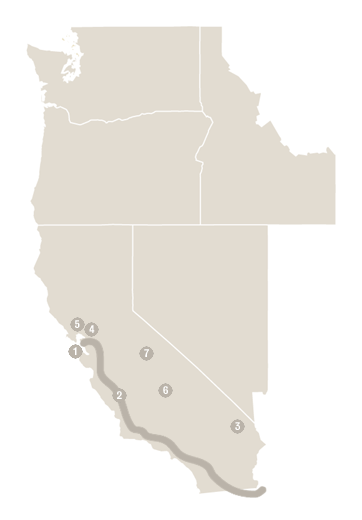Pacific
Click on the map to explore national parks associated with African Americans.
-
1 |
Golden Gate National Recreation Area, CA
Buffalo Soldiers served in the area. Buffalo Soldiers were African American soldiers organized after 1866 to facilitate Western expansion by non-Native American settlers and to confront American Indian resistance. The Southern Plains Indians called these men Buffalo Soldiers because they thought the hair of the African American soldiers looked like the hair between a buffalo's horns.
Presidio of San Francisco, a unit of this park, contains the San Francisco National Cemetery where Pvt. William H. Thompkins, a soldier in the African American 10th Cavalry during the Spanish-American War, is buried.
-
2 |
Juan Bautista de Anza National Historic Trail, AZ, CA
Approximately 25% of Juan Bautista's 1775 expedition to San Francisco and more than 50% of the initial settlement of Los Angeles in 1781 was African American. A History of Black Americans in California discusses the participation of African Americans in settling the West.
-
3 |
Mojave National Preserve, CA
During the early 1910s and 1920s, a community of African American homesteaders formed in the southeast Lanfair Valley, part of the park today. Parts of the valley are still privately owned by descendents of this settlement.
-
4 |
Port Chicago Naval Magazine National Memorial, CA
202 of the 320 sailors, marines, merchant marines, and workers killed during the explosion at Port Chicago Naval Magazine were African American. Five African Americans received the Navy's Bronze Star for their courage during the disaster. Surviving ammunition loaders were afraid unsafe conditions would lead to another disaster and mutinied after the explosion. Seaman Joseph Smalls was one of the mutineers. Survivors dedicated Port Chicago in 1994. The tragedy and its aftermath were catalysts towards persuading the military to examine racial injustice and inequality. Explosion and Mutiny from NPS Stories to Tell offers this description of the significance of these events.
-
5 |
Rosie the Riveter WWII Home Front National Historical Park, CA
During World War II, many African American men and women went to work to support the war effort. California's maritime industries attracted many workers causing this period in California history to be dubbed the Second Gold Rush. The city of Richmond, where this park is located, attracted 15,000 African Americans and still has a large African American community today.
-
6 |
Sequoia and Kings Canyon National Park, CA
Captain Charles Young, 9th Cavalry, was superintendent of Sequoia and General Grant Park (now Sequoia and Kings Canyon NP) in 1903. He was the first African American to hold this position. He was in charge of constructing roads, developing the park for tourism, and recommending acquisition of patented lands in the park. At the time of his appointment, he was the only active commissioned African American graduate of West Point.
-
7 |
Yosemite National Park, CA
In 1900, more than 400 African American Buffalo Soldiers protected Yosemite and Sequoia National Parks. Shelton Johnson, a current African American park ranger, is researching Buffalo Soldiers at Yosemite.


